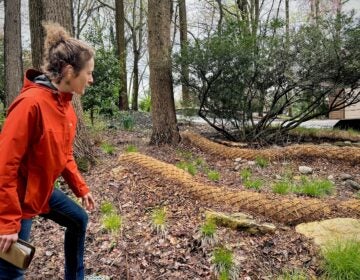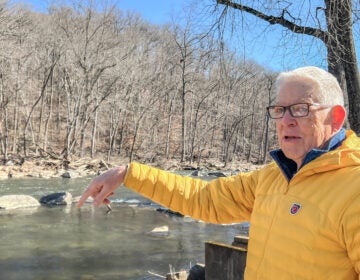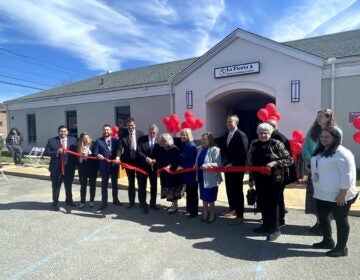Farm to faucet, enlisting Pa. farmers to keep Delaware’s water clean
A coordinated effort is working to keep Delaware’s water clean starting at the source across the border in Pennsylvania.
Listen 4:54When we turn on the tap for a drink of water, most of us never think about the journey that water takes to get to the faucet.
For some of that water, the journey starts at a farm near Landenberg, in Chester County, Pennsylvania. The Hoopes farm has been in operation for more than 200 years. It’s been run by a member of the Hoopes family since 1854. Today, Barclay Hoopes raises a few hundred dairy cows on the land.
“I just love this land and farm, and so do my children. Hopefully it will continue on, and it’s preserved, so that’s a good part of it,” Hoopes said.
And although they’re miles from the Delaware border, these idyllic hills play a big role in the quality of drinking water for thousands of Delawareans.
Hidden at the bottom of valley at the corner of the farm, a little trickle of water joins with dozens of others like it on the way to eventually becoming the White Clay Creek. But as the streams grow in volume, they also pick up nutrients, sediment and other pollutants along the way. That’s a problem for SUEZ Water, which takes water from the White Clay Creek, treats it, then delivers it to 100,0000 Delaware customers.
This stream’s close proximity to the Hoopes dairy farm poses a special hazard to Delaware water customers, according to Tom Hubbard of SUEZ Water. That hazard is an organism called cryptosporidium.
“It’s a parasite that lives in the cows’ intestinal track,” Hubbard said. “When they do ‘what they do,’ it gets into the water. But if you get the cows out of the water, and they’re not producing it in the water stream, then you’re not having to take it out when it gets down to the water stream.”
SUEZ has been working with farmers and other groups to move livestock away from the water.
“There’s no farmer that I know about that wants to pollute the water,” Hoopes said. “There’s a finite amount of fresh water in the world, and you’ve got to keep it clean.”
To do that, workers with Red Tail Restoration planted trees that will help create a 100-foot buffer around the water source to help filter runoff from the farm.
“Here we have a farm where the water is running into the stream off of a dairy operation,” said Red Tail’s Greg Gagliano. “As it goes in, it has the opportunity to percolate through the trees and get cleaner as it goes into those streams creating cleaner water downstream in Delaware and into ultimately the Delaware Bay.”
For SUEZ, keeping parasites and other pollutants out of the water is much more efficient and economical than treating it further downstream. Hubbard said the company had a choice when required to meet regulations to reduce cryptosporidium levels.
“We could either invest up to $20 million in our treatment plant to add treatment, which would have zoomed the cost for customers, would have increased our carbon footprint,” he said. “Or we could invest upstream $700,000 over five years to do these kinds of projects, and we reach the same goal of reducing pollution.”
Stroud Water Research Center is monitoring the progress at the start of the stream.
“We can begin to understand the total amount of material of things in the water that comes out of this valley,” said Stroud’s David Arscott. “Then, over time, we can analyze the quality of water, of how it changes in response to the restorations, the things we’re changing on the landscape.”
The tree planting will pay off in a variety of ways for water quality in addition to creating a buffer and removing excess nutrients or pollutants, Arscott said.
“Once the trees grow up, they shade the stream, they help buffer the temperature changes, they keep the stream water cooler which can help promote better fish communities,” he said.
The Hoopes project is just one of more than two dozen water-quality projects the company has undertaken.
About 10 miles north of Landenberg, workers are putting the finishing touches on another project to protect another source of Delaware’s drinking water, the Red Clay Creek.
Bob Struble helped shepherd this project with the Brandywine Red Clay Alliance, a group working to improve water quality in northern Delaware and Southeast Pennsylvania.
“It’s a horse farm, so we have a number of horses that are grazing each day,” he said. “It’s a good idea to keep them as far back from the stream as you can, so one of our projects here is to put fencing in and to keep them at least 35 feet away from the stream.”
With the buffer, the horses still have access to the stream, but they’re kept from standing in the water.
Brandywine Red Clay Alliance is working on a long-term project to bring streams that don’t meet water-quality standards into compliance. The group’s Red Streams Blue program is a holistic project to improve all streams in the Red Clay and Brandywine River watershed.
“Red streams on a map are streams that don’t meet state standards — Pennsylvania or Delaware standards. Blue streams do, so we want to make the red streams blue,” Struble said.
These projects all start with educating landowners and farmers like Barclay Hoopes on the impact their land can have on water quality in hopes of getting them to make voluntary changes.
“We’ve all got to be good neighbors. I couldn’t farm here if I wasn’t a good neighbor,” Hoopes said.
And just as it took years for area streams to become polluted, it will take years for these improvement efforts to have their full effect.
WHYY is your source for fact-based, in-depth journalism and information. As a nonprofit organization, we rely on financial support from readers like you. Please give today.





